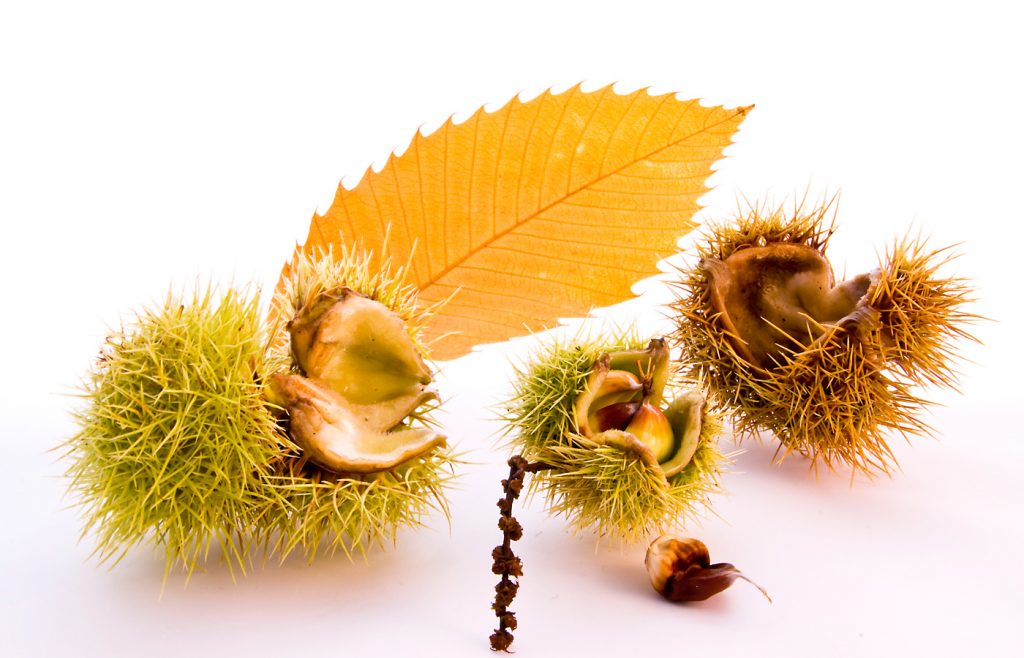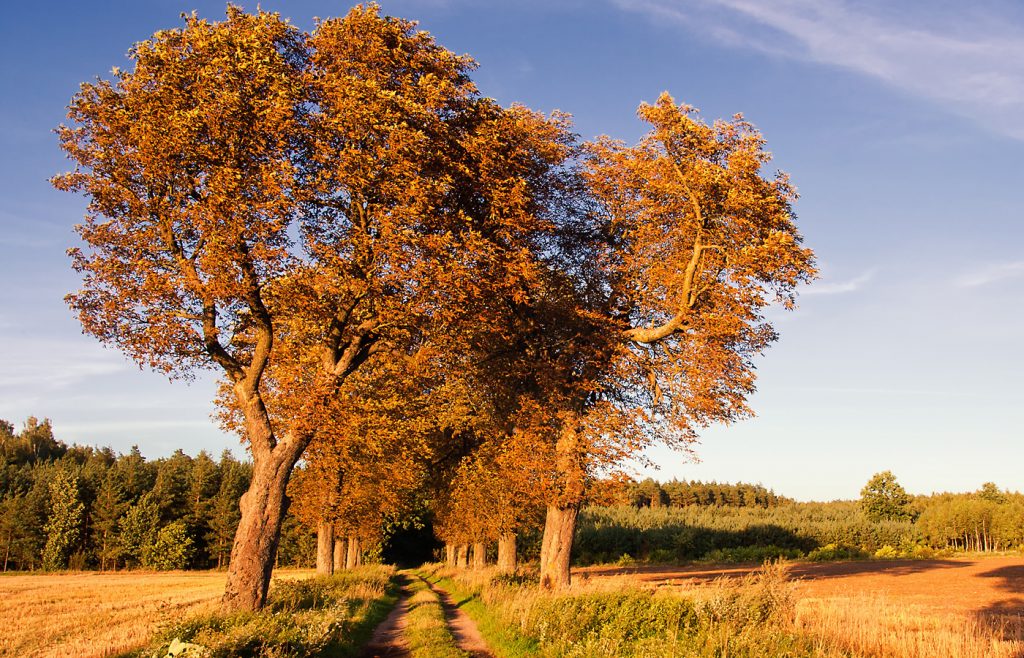
Every autumn, people all over the globe look forward to the chestnut harvest. Sweet, starchy, and delicious, chestnuts are one of the most widely consumed foods in the world—and have been for millennia, yet here in America we are missing out. From the perspectives of agricultural sustainability, culinary pleasure, and niche market sales, increased awareness of this amazing crop can only stand to better our local food network.
Chestnuts are popular for a variety of reasons. Unique for a tree crop, they contain mostly starch, making them sweet and filling. Most nuts are oil and protein, also good qualities, but not ideal for a staple crop. Secondly, chestnut trees often grow in areas unsuited for annual agriculture, such as rocky areas or on the flanks of hills and mountains. Lastly, chestnuts are a food with history—from Italy to China, people have been enjoying chestnuts for generations, gathering this nurturing abundance from the forest every fall.
Nuts and Timber
Chestnuts have been part of the human diet since the time of hunting and gathering. Even when humans settled and planted grain crops, chestnuts remained an important food source. In the mountains of northern Italy, chestnut flour was historically more common than wheat flour. People did not need to tend them—they were a free crop. The excess nuts that humans did not consume were eaten by animals, which later became human food. In parts of Spain and Italy, it is still common for farmers to turn their pigs loose in the chestnut forests in the fall so that they can fatten up for winter. In fact, hogs finished on chestnuts make some of the tastiest and most expensive hams you can find.
Not only is the chestnut an excellent food crop, it has another important yield—timber. In fact, the American chestnut was the tree that built America.

Before the 1890s, one-quarter of the trees in the eastern woodlands were American chestnut. They were fast growing, tall, straight, and extremely rot resistant. Nearly every cabin, barn, stable, and workshop was made of American chestnut. In pioneering days, the nuts were not overlooked either. Settlers used chestnuts as they had in the old country, except that the American nuts were sweeter and even more abundant.
To the Native Americans of the area, the nuts were an important crop as well. They made meal that was added to soups and stews as a thickener. Undoubtedly, the nuts were also simply roasted and eaten whole by the hearth fire.
Tragically, a fungal blight has made the American chestnut virtually extinct. By the 1950s the tree that once covered the land from Maine to Georgia and Kentucky to Connecticut was gone. All that remained were the towering bleached white trunks and the scattered stumps that sent up shoots of new growth, which would die of blight once they grew for 30 or so years, a mere fraction of the lifespan of these mighty forest creatures.
Although the American chestnut is virtually gone, a small group of dedicated scientists from the American Chestnut Foundation has been collecting nuts from the few remaining wild trees and breeding them with blight-resistant Chinese species.
Resistant New Hybrids
Iowa quite possibly has one of the best chestnut-growing climates west of the Mississippi, and many Chinese and Chinese-American hybrids perform handsomely in our slightly acidic rich soils. There are already a number of chestnut fields in Iowa and the growing demand far exceeds the local supply.
Interestingly, the founding members of the American Chestnut Foundation were Midwesterners from Minnesota. Their breeding work has led to a chestnut tree adapted to the harsh winters of the upper Midwest. For the last 30 years, Philip Rutter, founder and chief scientist at Badgersett Research Corporation, has been breeding chestnuts that combine the blight resistance of Chinese chestnuts with the coldhardiness, growth habit, and flavor of the American chestnuts. These hybrids offer a chance to create a truly long lasting, sustainable agriculture in the Midwest and eventually restore American chestnuts to their primacy in the woodlands of eastern North America.
In woody agriculture—a term used to describe farming with trees—hazelnuts and chestnuts are managed to supply annual crops of nuts and wood products. The nut crops from chestnuts and hazelnuts are similar to the typical corn and bean pairing, in that the chestnuts provide carbohydrates like corn and the hazels supply fats and protein like soybeans.
Both chestnuts and hazelnuts are well suited for coppicing, in which trees are cut to the ground and allowed to re-grow. The wood from a chestnut coppice can supply posts or be chipped for use in plywood-type products.
Woody agriculture has many ecological advantages over annual field crops like corn and beans. For one, trees help reduce erosion, as their roots hold the soil and their canopies continually drop organic matter onto the soil. Similarly, woody perennials help reduce the CO2 in the atmosphere.
Woody agriculture also makes sense economically. With an average price of $4 a pound for chestnuts and trees that can produce 2,000 pounds per acre, farmers can gross $8,000 from a small planting. Corn, by comparison, at $7 a bushel, provides around $1,400 per acre. Furthermore, chestnuts can be grown on ground too steep for row crops, and in the years before they begin to bear, other crops can be grown between the rows. In time, farmland will be forests and forests will be farms. Imagine the Iowa pork industry running hogs through acres of chestnuts each fall, creating free-range, tree-crop-finished meat.
Chestnut Stuffing
(Serves 8-10)
A great holiday dish!
1 lb. peeled chestnuts, coarsely chopped
2-3 large garlic gloves
1 yellow onion
3-4 carrots
3 stalks celery
1/2 cup cooked wild rice
5-6 cups torn or chopped slightly stale bread (crusty white or wheat)
1 cup vegetable or meat stock
2 tsp. apple cider vinegar
1/3 cup white wine
Fresh herbs (parsley, thyme, sage, etc.)
Olive oil
Butter
Cut an X into the rounded side of each chestnut. Place nuts on a baking sheet with 1/4 cup water and bake in a 450° oven for 10 minutes. Peel the nuts while still warm. (This same method is used to make roasted chestnuts, although they should be roasted for 15-20 minutes.)
In a large skillet, heat a healthy splash of oil and a tab of butter. When the butter foams, add enough cut bread to absorb the oil and fry until golden brown. You can also toss the bread with oil and bake at 350° until toasted.
Cut the onion, carrots, and celery in a fine dice.
Rough chop the peeled chestnuts.
Set bread aside and add more oil to the skillet. Sauté carrots, onions, celery, and garlic. Resist the urge to stir the pan for 45 seconds to a minute to ensure good caramelization, then toss the vegetables. Continue to sauté until color appears on the onions. Add chopped chestnuts and continue to cook on medium high for 2 minutes.
Turn down the heat to medium low, add cooked wild rice, wine, vinegar, and stock. Reduce until two-thirds of the liquid is gone. Add the toasted bread and chopped herbs to the mixture and mix thoroughly. Salt to taste. Continue cooking on low and stir until the moisture has been thoroughly absorbed by the bread. If it is too dry, add a little more stock and butter, until it has the consistency of moist cake. The stuffing can be put into a bird for roasting, or into a baking dish and roasted to give it a crunchy top.
For more information on growers and researchers, contact Tom Wahl of Wapello: www.redfernfarm.com or Badgersett Research Corporation.
